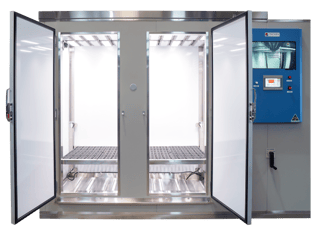
These sophisticated cabinets provide the perfect balance of light, temperature, humidity, and other environmental factors, making them invaluable in various fields of study, from agriculture and horticulture to ecological research and beyond. In this blog article, we aim to explore the features, applications, and benefits of plant growth cabinets, shedding light on their significance in unravelling nature's mysteries and advancing our understanding of plant life.
Understanding Plant Growth Cabinets
Plant growth cabinets are controlled environments designed to replicate specific ecological conditions for the study and cultivation of plants. These cabinets provide researchers with precise control over factors such as temperature, humidity, light intensity, and photoperiod, enabling them to manipulate these variables to simulate different climates and ecosystems. As a result, scientists can investigate how plants respond to environmental changes and optimize growth conditions for various plant species. Thermoline's range of Climatron cabinets covers the requirements needed by researchers.
Key Features of Plant Growth Cabinets
1. Light Control: Plant growth cabinets are equipped with lighting systems that can mimic different spectra, including natural sunlight, enabling researchers to study the impact of light on plant growth and development.
2. Temperature and Humidity Regulation: These cabinets can maintain constant temperature and humidity levels, replicating various climatic conditions, from arid deserts to tropical rainforests.
3. Adjustable Photoperiod: The photoperiod, the duration of light and dark periods in a day, can be programmed and modified in plant growth cabinets, allowing researchers to simulate different day-length conditions for various plant species.
4. Precise Environmental Monitoring: Plant growth cabinets feature sensors to monitor and record environmental parameters, providing researchers with real-time data on temperature, humidity, light, and other factors.
5. Ventilation and Airflow: To ensure proper air circulation, plant growth cabinets are designed with efficient ventilation systems that maintain consistent CO2 levels and prevent heat buildup.
Applications of Plant Growth Cabinets
1. Agricultural Research: In agriculture, plant growth cabinets are used to optimize crop production, study plant responses to climate change, and develop improved plant varieties with better yields and greater resistance to pests and diseases.
2. Environmental Impact Studies: Researchers utilize these cabinets to investigate how plants respond to changes in temperature, humidity, and CO2 levels, offering insights into the potential impacts of climate change on various ecosystems.
3. Plant Physiology and Biochemistry: Plant growth cabinets facilitate the study of plant physiology and biochemistry by providing controlled environments to examine processes such as photosynthesis, respiration, and nutrient uptake.
4. Horticulture and Floriculture: Plant growth cabinets play a crucial role in horticultural research, enabling the development of new ornamental plant varieties, studying optimal growing conditions, and extending the flowering season.
5. Ecological Studies: These cabinets are used to explore the growth patterns of various plant species under different environmental conditions, contributing to our understanding of ecological dynamics and biodiversity.
Benefits of Using Plant Growth Cabinets
1. Controlled Experiments: Plant growth cabinets provide a reliable and controlled setting for conducting experiments, eliminating external variables and ensuring more accurate and reproducible results.
2. Increased Research Efficiency: Researchers can perform multiple experiments simultaneously in plant growth cabinets, optimizing time and resources.
3. Conservation and Biodiversity: By understanding how different plant species respond to environmental changes, plant growth cabinets contribute to conservation efforts and the preservation of biodiversity.
4. Crop Improvement: Plant growth cabinets aid in the development of new crop varieties that are more resilient, nutritious, and suitable for specific agricultural practices.
5. Sustainable Agriculture: By studying plant responses to environmental stressors, plant growth cabinets help in the development of sustainable agricultural practices that can mitigate the impacts of climate change.
Conclusion
Plant growth cabinets have revolutionized the way we study and understand plant life. These versatile and precise tools allow researchers to create controlled environments that simulate various ecosystems, making them invaluable in agricultural research, ecological studies, and the development of sustainable practices. As our knowledge of plant growth and environmental interactions expands, plant growth cabinets will continue to be at the forefront of scientific discoveries, offering valuable insights into the complexities of nature and helping us address critical global challenges.
Our sales team is happy to help with any enquiries.






